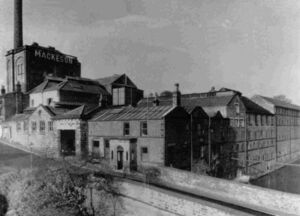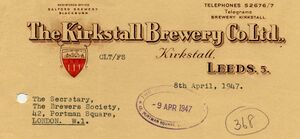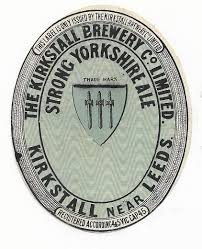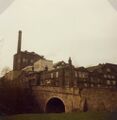Kirkstall Brewery Co Ltd
Kirkstall Brewery Co. Ltd, Kirkstall, Leeds, West Yorkshire.
Operated by Thomas Walker from before 1834. Acquired by Benjamin Dawson c.1845. Registered June 1871 to acquire Benjamin Dawson & Co. Reconstructed company registered January 1899.
Acquired by Dutton's Blackburn Brewery Ltd. 1936 with 83 public houses.
Brewery bought by Whitbread & Co. Ltd. 1953 and was closed in January 1983.
Now student accommodation.
NEW WINE, OLD BOTTLES by Peter Brears, Director of Leeds City Museums
With its fine Victorian brewing tower, Kirkstall Brewery is a much-loved landmark in Leeds. Peter Bre ars reflects on the proud history of the former brewery which its new owner, Leeds Metropolitan University, plans to develop into accommodation for over 1,000 students.
Down at Broad Lane, just south of Kirkstall Bridge, work is about to start on the conversion of the former Kirkstall Brewery into student accommodation for Leeds Metropolitan University. Most local people remember the fine malt and hop aromas it produced when Whitbread was brewing its Mackeson Stout. Whitbread Tankard, Yorkshire Bitter and mild ales here; but very few had any knowledge of the history of the brewery, or the processes carried on behind its impressive stone facade, which rises dramatically from the waters of the Leeds and Liverpool Canal. I first got to know the brewery in March 1993, when the City Council purchased it for conversion into a brewery museum, thus saving it from certain demolition. Over the following year of research and recording, the story of its history and development slowly began to emerge.
In the medieval period the powerful springs which still flow here were tapped by the Cistercian monks. They laid lead pipes to carry the crystal-clear water beyond the river, and into their abbey at Kirkstall. From this period the area formed part of Monk Wood, Sir James Graham, the major local landowner, then dividing it up into development plots in 1793. The first plot, in the angle between Broad Lane and the canal, was leased to Joseph Musgrave, who built a large maltings, a house and cottages here above a range of huge vaulted cellars.
The maltings were operated by Ephraim Elsworth from 1814 to 1832, but in the following year Thomas Walker of Hunslet bought them for £7,000 and converted them into a very well equipped brewery. The Duke of Wellington's Beerhouse Act of 1830 had just given an enormous boost to the brewery trade, and this looked like a very good investment. However, the building costs proved to be too much for Walker's resources, and he died bankrupt in 1844, still owing the Musgraves the original purchase money. Now the Musgraves sold the brewery to Benjamin Dawson & Co. who very successfully expanded the business, so that a much larger building was required.
On the next plot upstream, a maltster called Henry Cooper had built himself a fine residence called Cooper House (which still exists, having been fully restored by the City Museum), a house called Poplar House for his manager, and a long maltings and wharf running alongside the canal. Benjamin Dawson was able to purchase these in 1867, then demolishing the maltings, and erecting in their place the present enormous four storey warehouse-like building, where the beer was prepared and stored ready for dispatch onto canal boats. A legal battle for control of the brewery following Dawson's death in 1869 resulted in its sale in 1872, when it was purchased by the Kirkstall Brewery Company for £22,400.
About this time the brewery was producing 26,000 barrels of beer each year, but by re-equiping the plant, and building a high tower brewery so that it could operate on the gravity principle, annual production was brought up to 72,000 barrels by 1898. These vast supplies of India Pale Ales, strong ale, mild ale, light bitter, imperial stout, double stout and porter were not only sold in Leeds and throughout Yorkshire but were carried to much more distant locations. In 1896 the brewery had bought the SS Charante and the SS Kirkstall to transport its products to Australia and New Zealand, probably the world's longest beer run! As the company continued to prosper, it eventually took over the Albion Brewery in Woodhouse Lane and the Willow Brewery on Kirkstall Road, thus acquiring a large number of its own public houses.
Despite these successes, the Kirkstall Brewery Company was itself taken over by Dutton of Blackburn in 1936, then making Dutton's Green Label, No.3 and Pale Ale. In 1954 the company went into voluntary liquidation, the brewery being immediately purchased by Whitbread, who completely modernised the brewing plant to commence brewing Mackeson Stout in 1957, and Whitbread Tankard in 1961 Further expansion around 1970 enabled the brewery to produce 250,000 barrels of mild and bitter each year, in addition to racking a further 140,000 barrels of ales and lagers.
By the early 1980s changing tastes and economic factors caused a considerable reduction in the sale of beer, with the result that Whitbread closed the Kirkstall Brewery in January 1983. It was then purchased by Leeds City Council for conversion into a visitor centre, with a Yorkshire brewing museum, public house and restaurant, and a wealth of other attractions. Instead, it eventually provided a base for the city's Christmas lights workshop, until being sold to Leeds Metropolitan University for conversion into student housing.
All its historic buildings now have an assured future, however, effectively commemorating the fine 150-year tradition of brewing in Kirkstall.
This article first appeared in Metropolitan, the magazine of Leeds Metropolitan University. The editor is grateful to them for their assistance in obtaining permission to reproduce it.
An assortment of images of the brewery
The brewery today as student accommodation
|















